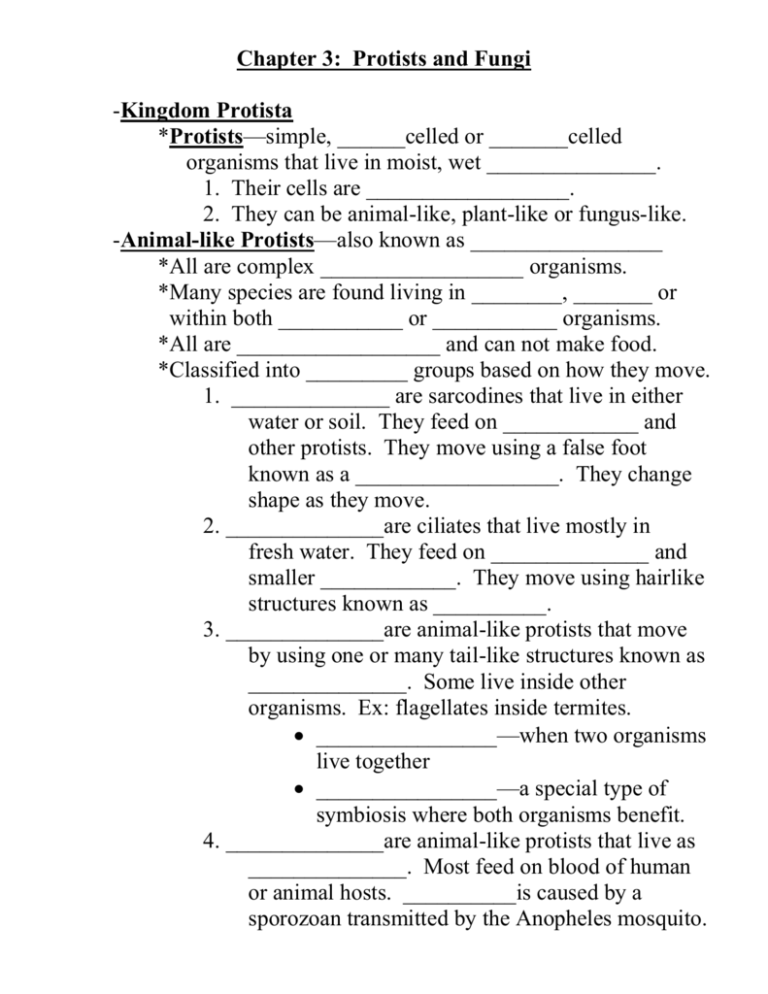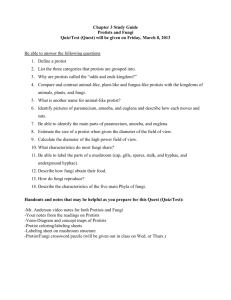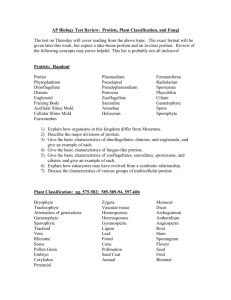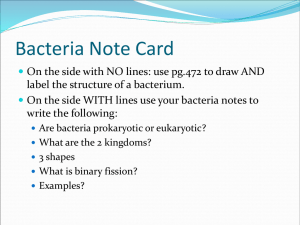Chapter 3: Protists and Fungi
advertisement

Chapter 3: Protists and Fungi -Kingdom Protista *Protists—simple, ______celled or _______celled organisms that live in moist, wet _______________. 1. Their cells are __________________. 2. They can be animal-like, plant-like or fungus-like. -Animal-like Protists—also known as _________________ *All are complex __________________ organisms. *Many species are found living in ________, _______ or within both ___________ or ___________ organisms. *All are __________________ and can not make food. *Classified into _________ groups based on how they move. 1. ______________ are sarcodines that live in either water or soil. They feed on ____________ and other protists. They move using a false foot known as a __________________. They change shape as they move. 2. ______________are ciliates that live mostly in fresh water. They feed on ______________ and smaller ____________. They move using hairlike structures known as __________. 3. ______________are animal-like protists that move by using one or many tail-like structures known as ______________. Some live inside other organisms. Ex: flagellates inside termites. ________________—when two organisms live together ________________—a special type of symbiosis where both organisms benefit. 4. ______________are animal-like protists that live as ______________. Most feed on blood of human or animal hosts. __________is caused by a sporozoan transmitted by the Anopheles mosquito. -Plant-like Protists—also known as __________. *They can be ______celled, ________celled or live in colonies *They all contain _____________ and are ______________. *Most species are part of the _________ in lakes and oceans. *Six different groups: 1. _____________—a common euglenoid that lives in fresh water. In sunlight, many can make their own __________. Without sunlight, they can eat food. 2. ________________—plant-like, unicellular protists found in lakes and oceans. Most contain golden brown ____________ that hide their green chlorophyll. Covered by shells that contain __________. Used to make _________________ ________________________________________ Come in many __________ and patterns. Form diatomaceous earth when they _____ 3. ________________—plant-like protist with red pigments. Also known as ________________. All are ________ celled. All have _______flagella and ______as they move. Found in ________________ Can cause _________________ 4. __________________—plant-like protists that contain chlorophyll and are _____________________. Can be _____ celled, _______ celled or live in colonies. Found in fresh water, salt water or on land. 5. _________________—plant-like protists that live deep in the ocean. All are _______ celled and _______ in color. Used to make _________________ and _____________ creamy, to make agar and hair conditioner, or eaten fresh, dried or toasted. 6. ________________—giant kelps are examples. They live in shallow ocean waters. All are _______ celled and grow very tall--______. Used to make ___________________________________________ -Algal Blooms *________________—rapid growth of a population of algae in either saltwater or freshwater. 1. Saltwater blooms—also known as _______________. An increase in ________________ or water ________________causes the algae population to increase. Toxins produced by the algae build up in fish and shellfish. Organisms that eat these (_________________) can become sick or die. 2. Freshwater blooms—nutrients, like nitrogen and phosphorus, build up in lake or ponds and causes algae to increase, producing a ________________ on the surface water. This is known as ___________________. Sunlight can’t reach the plants below so they die, bacteria decompose them and use up all the oxygen so fish die. All that lives is the algae on the surface. Human activities can cause eutrophication: __________________ into lakes and streams __________________ into lakes and streams -Fungus-like Protists—also known as ________________ and _________________. They have features of both protists and fungi. -Kingdom Fungi * Most __________ are many-celled _______________ that can not make _________ and can not__________________. *They get food by ________________dead organic matter. (_______________) *Some get food from living hosts. (______________) *They use ___________to reproduce. *Their cells are arranged in a structure called _____________. -Obtaining Food *Absorb food through hyphae that grow into the food source. 1. Hyphae are thread-like tubes of ______________ that contain many nuclei. Substances move quickly and freely through the hyphae. It is the ___________ part of the fungus. 2. Often, hyphae grow underground and may join to form above ground structures like ______________ -Reproduction: Fungi reproduce both ________________ and _______________ * Reproduce asexually by forming _______ or by __________ 1. Spores are _________________. 2. Produced inside ____________________. 3. Appearance of fruiting bodies varies. 4. ______________ occurs mostly in yeast cells: small bud breaks off of the parent cell. *Reproduce sexually when hyphae of tow different fungi grow together and exchange ______________________. -Classification of Fungi: Three major groups *________________—mushrooms, bracket fungi, rusts and puffballs. They produce spores in club-shaped structures. Most poisonous fungi are in this group. *________________—yeasts, molds and truffles. They produce spores in sac-shaped structures. *_______________—fruit and bread molds. They produce spores in round spore cases. -Role of Fungi in Nature: Fungi play many roles in nature *Decomposers and recyclers—break down dead ________ and __________ matter and return _____________ to soil. *Food providers 1. ____________ used to make bread and wine. 2. Some __________ used to make cheese. 3. Some ________________ are edible (some are very poisonous) *Fight disease—Penicillin is made from the fungus, Penicillium, discovered by ____________________ in 1928. Many other _______________ are also made from fungi. *Cause disease—fungi cause plant diseases like Dutch elm disease. ________________ and __________________ are also caused by a fungus. *Fungus-Plant Root Association—helps plants grow better. Hyphae absorb ______________________ for plant; plant makes _____________________ for fungi. *Lichens—fungus and algae (or bacteria) growing together. Algae makes _________ for fungus; fungus improves _______________________ for algae. Known as a __________________________.









